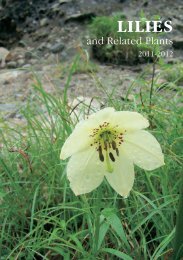LILIES - RHS Lily Group
LILIES - RHS Lily Group
LILIES - RHS Lily Group
Create successful ePaper yourself
Turn your PDF publications into a flip-book with our unique Google optimized e-Paper software.
18<br />
The lilies of Greece<br />
Arne Strid writes about the five species endemic to this ancient land.<br />
HE GENUS LILIUM is represented by five species within the borders of present-<br />
Tday<br />
Greece, but probably only two of them were known in antiquity. The<br />
famous “lilies” of Minoan wall paintings in Crete and Santorin (Thira) are not lilies<br />
as currently understood, but represent the sea daffodil, Pancratium maritimum<br />
(Amaryllidaceae), a species of sandy beaches still widespread throughout Greece<br />
although declining through development of tourist facilities.<br />
Plant names used by Theophrastos (c. 370-285 B.C.) are often difficult to<br />
interpret, but it seems fairly certain that κρι´νον (krinon) refers to the white<br />
Madonna <strong>Lily</strong> (Lilium candidum). Κρι´νον το πορφυρου´ν (krinon to porfiroun)<br />
may refer to the scarlet Lilium chalcedonicum which occurs in mountains of<br />
the Peloponnese and Sterea Ellas, including Parnes or Parnitha near Athens,<br />
and may well have been known to Theophrastos. Ημεροκαλλζς (imerokalles)<br />
has been interpreted as Lilium martagon but this seems more doubtful both<br />
for etymological reasons and for the fact that the latter occurs mainly in the<br />
northern parts of modern Greece, reaching its southern limit in Parnassos and<br />
other mountains of central Sterea Ellas.<br />
Modern botanical exploration of Greece started with John Sibthorp (1758-<br />
1796) who on his grand tour in 1786-1787 and on a subsequent tour in 1794<br />
gathered the material for the magnificent Flora Graeca, which appeared in ten<br />
folio volumes in 1806-1840, i.e., long after the death of Sibthorp. Flora Graeca<br />
contains 966 hand-coloured copper engravings based on drawings made in the<br />
field by the artist Ferdinand Bauer who had travelled with Sibthorp – alas, not a<br />
single lily.<br />
Flora Graeca was preceded by an octavo work without illustrations, the Florae<br />
Graecae Prodromus (1806-1816), which amounts to a comprehensive Flora of the<br />
areas visited by Sibthorp, i.e. southern parts of present-day Greece and coastal<br />
regions of western Anatolia as well as Cyprus. Three lilies are mentioned in<br />
the Prodromus, viz. Lilium candidum, L. chalcedonicum and L. martagon. All<br />
three had been known to Linnaeus who in Species Plantarum (1753) cited them<br />
from “Palaestina, Syria”, from “Persia” [probably in error], and from “Hungaria,<br />
Helvetia, Sibiria, Lipsiae”, respectively.<br />
In the Prodromus geographical information for Lilium candidum reads: “In<br />
Tempis Thessaliae. D. Hawkins. In hortis Graeciae frequens. Sibth.”. Apparently,<br />
John Hawkins, another wealthy English gentleman who had travelled in Greece<br />
partly together with Sibthorp and partly on his own, had observed this species<br />
growing in the Tembi valley in Thessaly (just south of Mount Olympus) whereas




